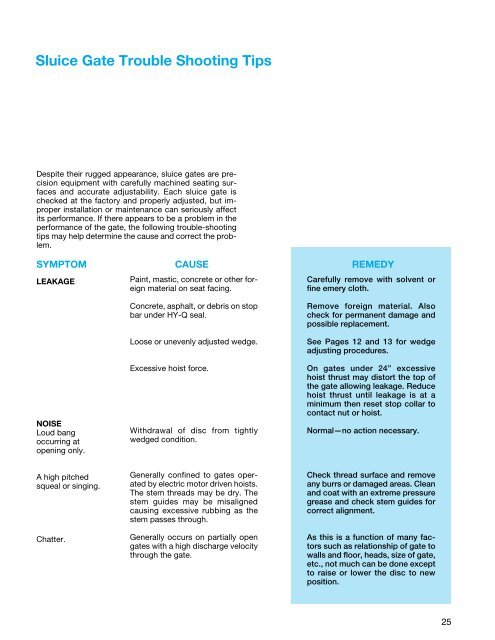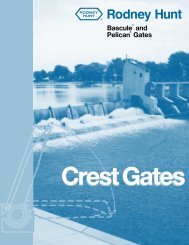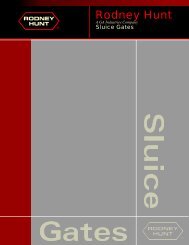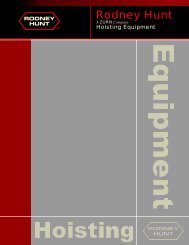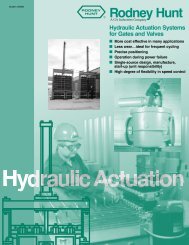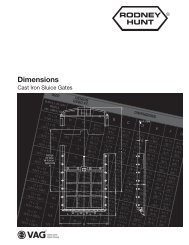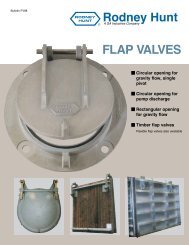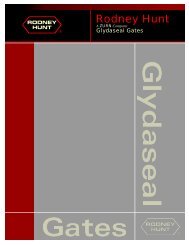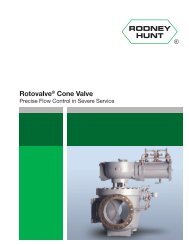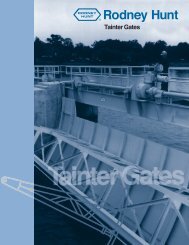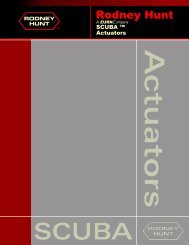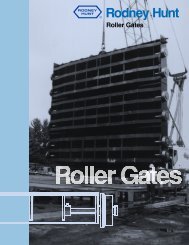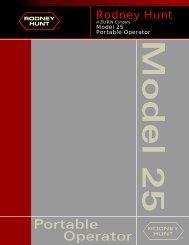Instruction Manual - Rodney Hunt Company
Instruction Manual - Rodney Hunt Company
Instruction Manual - Rodney Hunt Company
Create successful ePaper yourself
Turn your PDF publications into a flip-book with our unique Google optimized e-Paper software.
Sluice Gate Trouble Shooting Tips<br />
Despite their rugged appearance, sluice gates are precision<br />
equipment with carefully machined seating surfaces<br />
and accurate adjustability. Each sluice gate is<br />
checked at the factory and properly adjusted, but improper<br />
installation or maintenance can seriously affect<br />
its performance. If there appears to be a problem in the<br />
performance of the gate, the following trouble-shooting<br />
tips may help determine the cause and correct the problem.<br />
SYMPTOM CAUSE REMEDY<br />
LEAKAGE<br />
NOISE<br />
Loud bang<br />
occurring at<br />
opening only.<br />
A high pitched<br />
squeal or singing.<br />
Chatter.<br />
Paint, mastic, concrete or other foreign<br />
material on seat facing.<br />
Concrete, asphalt, or debris on stop<br />
bar under HY-Q seal.<br />
Loose or unevenly adjusted wedge.<br />
Excessive hoist force.<br />
Withdrawal of disc from tightly<br />
wedged condition.<br />
Generally confined to gates operated<br />
by electric motor driven hoists.<br />
The stem threads may be dry. The<br />
stem guides may be misaligned<br />
causing excessive rubbing as the<br />
stem passes through.<br />
Generally occurs on partially open<br />
gates with a high discharge velocity<br />
through the gate.<br />
Carefully remove with solvent or<br />
fine emery cloth.<br />
Remove foreign material. Also<br />
check for permanent damage and<br />
possible replacement.<br />
See Pages 12 and 13 for wedge<br />
adjusting procedures.<br />
On gates under 24” excessive<br />
hoist thrust may distort the top of<br />
the gate allowing leakage. Reduce<br />
hoist thrust until leakage is at a<br />
minimum then reset stop collar to<br />
contact nut or hoist.<br />
Normal—no action necessary.<br />
Check thread surface and remove<br />
any burrs or damaged areas. Clean<br />
and coat with an extreme pressure<br />
grease and check stem guides for<br />
correct alignment.<br />
As this is a function of many factors<br />
such as relationship of gate to<br />
walls and floor, heads, size of gate,<br />
etc., not much can be done except<br />
to raise or lower the disc to new<br />
position.<br />
25


